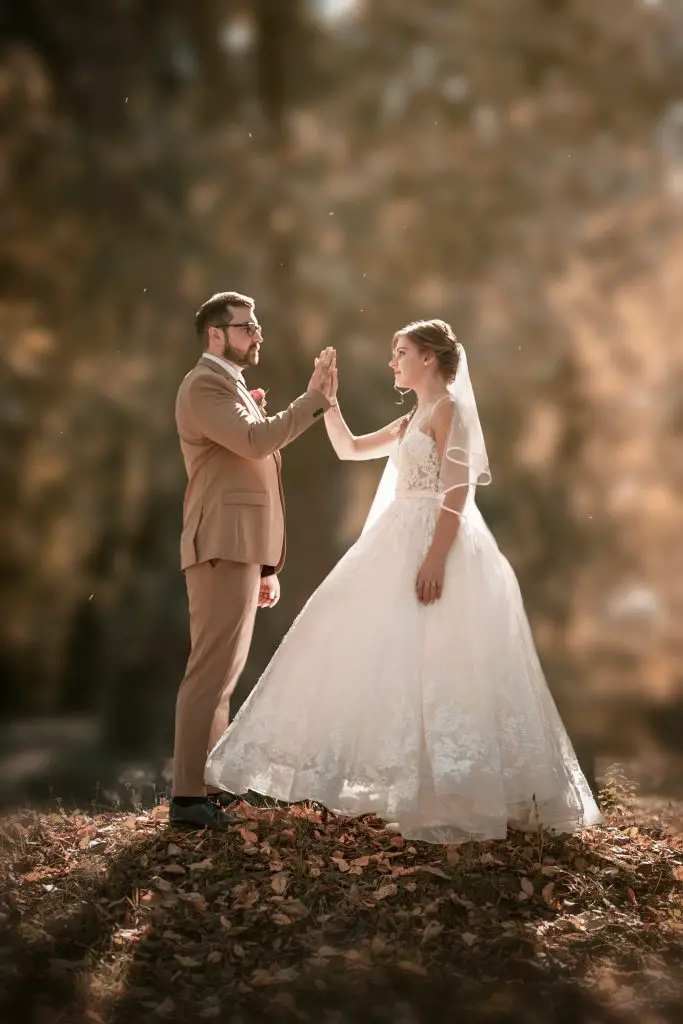A Jewish wedding is rich in tradition, combining biblical, historical, cultural, and legal elements that have evolved over 3,800 years. The wedding ceremony reflects the union of two individuals and the deep connection between the Jewish people and their faith.
In Jewish tradition, marriage is considered a holy covenant, often likened to the marriage between God and the Jewish people at Mount Sinai. The wedding is filled with symbolic rituals designed to bring joy, reflection, and a sense of spiritual connection.
Let’s get straight to the point
A Jewish wedding is deeply rooted in biblical, historical, and cultural traditions. It symbolises a holy covenant between the couple and God. The ceremony consists of several key stages, including setting the wedding date in accordance with Jewish laws, pre-wedding festivities (Kabbalat Panim), and veiling the bride (Badeken).
The wedding itself takes place under a Chuppah, representing the couple's new home. It has two main parts: Erusin (betrothal) and Nissuin (marriage completion). The ceremony involves rituals such as ring exchange, the reading of the Ketubah (marriage contract), and the breaking of a glass to symbolise both joy and remembrance of the destruction of the Temple.
After the ceremony, the couple spends private time in the Yichud room before joining their guests for a joyous wedding reception filled with traditional dancing and blessings. Each process step reflects centuries-old traditions, reinforcing the couple's spiritual and emotional connection.
The Basics of a Jewish Wedding

A Jewish wedding is much more than a celebration of love. It is a deeply spiritual and religious event, often seen as reenacting the covenant between God and Israel. Jewish weddings include several traditions influenced by the Bible and centuries of Jewish history. Even though some customs may vary depending on the specific Jewish denomination—Orthodox, Conservative, or Reform—the fundamental elements remain consistent across communities.
While some couples choose to personalise their weddings, these core traditions often form the backbone of the ceremony.
Cultural Background of Jewish Weddings
Jewish weddings have roots that date back to biblical times. Traditionally, marriages were arranged within the same household or tribe. This was to maintain religious and cultural continuity. In Orthodox Jewish communities, many of these traditions are strictly followed, while Reform Jewish weddings may incorporate more modern elements and exclude some traditional practices. Conservative Jews, on the other hand, tend to strike a balance, combining both traditional and contemporary elements in their wedding ceremonies.
Key Stages of a Jewish Wedding
A traditional Jewish wedding is divided into Erusin (betrothal) and Nissuin (marriage). These stages involve several key rituals that mark the couple’s marriage transition.
1. Setting the Wedding Date
Choosing the right wedding date can be challenging for Jewish couples because of religious restrictions. Jewish weddings are typically not held on the Sabbath (from Friday evening to Saturday evening) or on major Jewish holidays such as Yom Kippur, Rosh Hashanah, Passover, and Shavuot. In addition, weddings are discouraged during specific mourning periods on the Jewish calendar, such as the Omer and the three weeks leading up to the Ninth of Av.
Due to the complexity of the Jewish lunar calendar, couples must consult with a rabbi to select an appropriate wedding date.
2. Pre-Wedding Festivities (Kabbalat Panim)
Before the wedding ceremony, it is customary to have a Kabbalat Panim, or pre-wedding reception, where the bride and groom are treated like royalty. The bride and groom traditionally do not see each other for a week before the wedding, heightening their anticipation for the big day.
The bride’s reception is held in a separate room, often with her family and friends, while the groom’s reception may include singing and toasts from his side of the family. Light snacks and drinks are usually served during this time.
Two important contracts are currently signed: the Tenai'm (engagement agreement) and the Ketubah (marriage contract). After the Tenai'm are read, the mothers of the bride and groom are customary to break a plate, symbolizing the seriousness of the commitment.
3. The Badeken (Veiling of the Bride)
One of the most significant pre-ceremony traditions is the Badeken or veiling of the bride. The groom performs this ritual and covers the bride’s face with a veil. This practice recalls the biblical story of Rebecca, who veiled herself before meeting Isaac.
The veil symbolises the groom’s recognition that he is marrying not just the bride’s physical beauty but also her inner character. Once veiled, the bride receives blessings from her parents, and the groom returns to his reception area, awaiting the start of the ceremony.
4. The Chuppah (Wedding Canopy)
The Chuppah is one of the most iconic elements of a Jewish wedding. It is a simple canopy, open on all sides, under which the wedding ceremony takes place. The open sides represent the couple’s new home, which will always be open and welcoming to friends and family. The Chuppah is usually held outdoors, symbolising the blessing of the heavens on the marriage.
Under the Chuppah, the couple participates in the first part of the wedding, known as Erusin. This is the formal wedding, during which the bride and groom exchange rings and commit to each other.
5. The Wedding Processional
In Jewish weddings, the bride and groom are escorted to the Chuppah by their parents or a couple they admire, symbolising the passing of traditions from one generation to the next. The bride walks in circles around the groom several times, a custom rooted in Ashkenazi tradition. These circles represent a protective boundary around the groom, signifying the bride’s desire to create a safe and holy space for their union.
6. The Betrothal (Erusin)
The Erusin marks the beginning of the marriage ceremony. The rabbi recites blessings over a cup of wine, symbolising joy in Jewish tradition. The couple drinks from the cup as a symbol of their shared future. The groom then places a ring on the bride’s finger, completing the Kiddushin, or wedding. This is considered binding, and the marriage is now official under Jewish law.
7. The Ketubah (Marriage Contract)
After the ring ceremony, the Ketubah, or marriage contract, is read aloud. The Ketubah outlines the groom’s obligations to his bride, including providing for her material and emotional needs. It is an important legal document in Jewish marriages, symbolising the seriousness of the commitment the couple is making.
Once the Ketubah has been read, the groom presents it to the bride as a token of his commitment.
8. The Nissuin (Completion of the Marriage)
The Nissuin is the final step of the wedding ceremony. It is marked by the recitation of the Sheva Brachot (Seven Blessings). These blessings celebrate the couple’s union and ask for divine blessings for their future together. Honoured guests are often invited to recite the blessings, making this part of the ceremony a communal experience.
After the Sheva Brachot, the couple drinks from a second cup of wine. The groom then breaks a glass under his foot, a custom that reminds everyone of the destruction of the Temple in Jerusalem, even in times of great joy. The breaking of the glass also symbolises the fragility of human relationships and the need to cherish and protect them.
Post-Ceremony Traditions

1. Yichud (Seclusion)
After the ceremony, the couple retreats to a private room, the Yichud room, where they can spend a few quiet moments alone. This seclusion symbolises their new life together. In some traditions, the couple breaks their fast in the Yichud room, sharing their first meal as husband and wife.
2. The Wedding Reception
The wedding reception is a time of joyous celebration. In traditional Jewish weddings, dancing is a key element, with separate circles for men and women. Guests perform dances and acrobatics to entertain the bride and groom, and everyone is encouraged to join in the fun. The bride and groom are often lifted in chairs during the Hora, a popular Jewish dance.
3. Mealtime Blessings and Sheva Brachot
At the wedding feast, the Sheva Brachot are recited once again. These blessings, which were first said under the Chuppah, are repeated after the meal to continue the celebration of the couple’s union. The grace after meals includes the blessings over wine, and the couple drinks from a shared cup, symbolising their unity.
Conclusion
A Jewish wedding is a beautiful and deeply spiritual event, filled with centuries-old traditions that honour the couple and their faith. From selecting the wedding date to the final blessings of the reception, each ceremony stage is infused with symbolism and meaning. The Erusin and Nissuin, the Chuppah, the Ketubah, and the Sheva Brachot all work together to create a wedding that celebrates the couple's love for one another and their commitment to building a life grounded in Jewish values.
As you plan or participate in a Jewish wedding, remember to take joy in each step and embrace the rich traditions that make the day so special.
FAQs About Jewish Weddings
The Jewish marriage ceremony lasts more than a single day. The "wedding" ceremonies started with the choice to tie the knot. At the tenaim ceremony, a commitment contract is read and a dish is broken to symbolise the future marriage.
First female enquiry. Your first question in this section. Men can be curious, too.
Females dislike black clothes? Nope. Some may even require it. Black will never go out of style, despite its reappearance.
No short skirts, dresses, or low-cut shirts (most guests will have collarbones covered). Here's some clothes info. We call that a "shell" It boasts a sleek crew neck and long sleeves, making it a versatile layering garment. Many women will wear this creative clothing.
Your black suit is ideal for formal events. Orthodox weddings rarely feature tuxedos. Just wear a tie. The yarmulke adds to your difficulty. Orthodox weddings require yarmulkes. If you want to blend in, leave the satin yarmulke at home and see what the locals like.
Men traditionally wear Kippahs or Yarmulkas and women shoulder-covering gowns.
Jewish prenuptial agreements were devised recently by Jewish religious entities to protect wives from their husbands' possible refusal to issue a payout in the case of a divorce. Many countries, including the UK, US, and Israel, have developed and broadly adopted similar documents. However, not everyone agrees with this method; the Orthodox in particular have been sceptical.
The Lieberman clause was created by conservative Jews to ensure that no husband could ever refuse to grant his wife a get. The ketubah is designed to do this with built-in provisions; hence, should certain events occur, the divorce will be finalised instantly.
Judaism considers marriage to be the formalisation of a ritual purification between a Jewish man and a Jewish woman in which they involve God. There are two ways a Jewish marriage might come to an end: either one of the spouses dies or the husband gives his wife a divorce certificate. In Talmudic times, some provisions were added, especially to safeguard the woman.
Changes in who can marry who are the result of non-Orthodox trends. However, there is some disagreement about whether or not it is desirable to avoid intercultural marriage.
According to the Talmud, a man must keep his wife's physical being safe. In the event of his wife's illness, he would be obligated by the Talmud to cover any and all medical costs that may arise; he must see that his wife receives treatment. Even though his wife had been unwell for a long time, some renowned rabbis throughout history opposed divorce as inhumane behaviour, so he couldn't use it to get out of paying for her medical bills.

